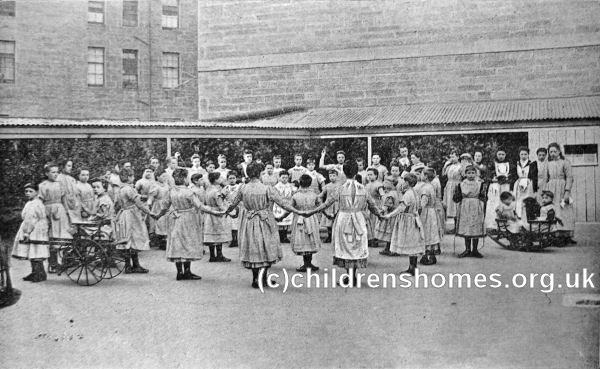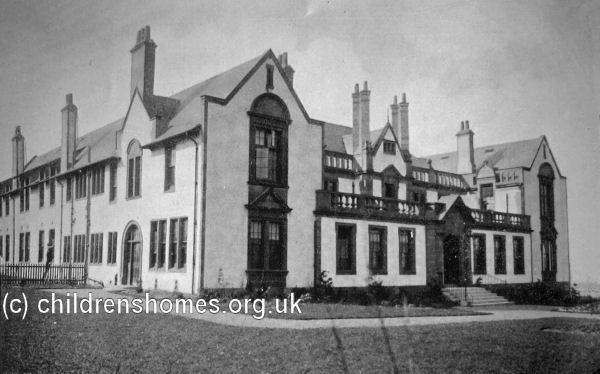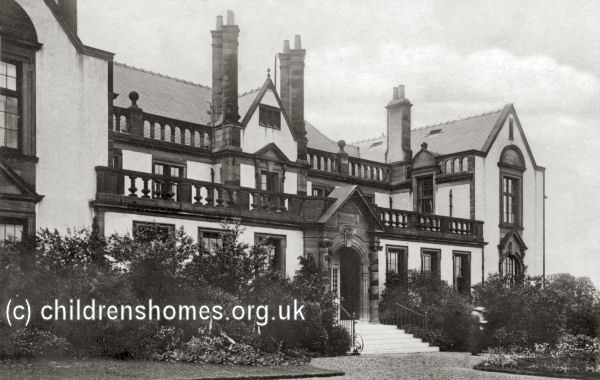Edinburgh Original Industrial School for Girls, Gilmerton, Midlothian, Scotland
Edinburgh's Original Industrial School for Girls was founded in 1847 by Dr Thomas Guthrie, originally occupying premises in the Old Town at 533 Lawnmarket, then moving a short distance to Ramsay Lane. In 1875, the girls moved to their own accommodation at Lovers' Lane (subsequently renamed Brunswick Road), off Leith Walk.

Edinburgh Original Industrial School for Girls site, Leith Walk, c.1896.

Edinburgh Original Industrial School for Girls, Edinburgh, c.1899. © Peter Higginbotham
After almost thirty years at Lover's Lane, more modern and spacious premises became necessary and a three-acre site was acquired on Edinburgh (now Gilmerton) Road, Gilmerton, about five miles out of the centre of Edinburgh. The Brunswick Road establishment remained in use as an Auxiliary Home, remaining in the charge of its long-serving superintendent, Mrs McKenzie.
The Gilmerton premises were formally certified for use as an Industrial School on 24 September 1904, providing accommodation for 75 girls aged from 6 to 10 years at their date of admission. The official opening ceremony of the establishment performed on 22 October by Colonel R.G. Gordon Gilmour. The building, designed by Messrs McArthy and Watson of Edinburgh, formed three sides of a quadrangle and was two storeys in height. The entrance frontage, facing the road, was 110 feet long and recessed in the centre on the upper floor. On the ground floor were an entrance hall leading into a wide corridor, extending nearly the whole length of the frontage, which gave access to the waiting-room , matron's room, officials' dining room, girls' dining hall, sick room, and in the centre overlooking the quadrangle a large apartment containing wardrobes for each girl. On the south side of the quadrangle were classrooms and the gymnasium, and on the north side were kitchen, offices, store-rooms etc. and the laundry block. The upper floor contains the officials' bedrooms and girls' dormitories, with the bathrooms and lavatories centrally placed between the dormitories. Two staircases gave access to the upper floor, and fire escape stairs were provided from the dormitories to the ground. All the external walls were constructed of hollow brickwork, with redstone dressing and harled, tinted s greyish-white. The roofs were covered with red tiles. The vacant ground was laid out with shrubbery, a vegetable garden and playground facilities,
The School site is shown on the 1908 map below.

Edinburgh Original Industrial School for Girls site, Gilmerton, c.1908.

Edinburgh Original Industrial School for Girls, from the east, Gilmerton, c.1908. © Peter Higginbotham

Edinburgh Original Industrial School for Girls, from the east, Gilmerton, c.1908. © Peter Higginbotham

Edinburgh Original Industrial School for Girls, from the east, Gilmerton, c.1909. © Peter Higginbotham
Miss Rose was initially appointed as superintendent at Gilmerton but she departed in February 1905 and was replaced by Miss MG Lowe. Other staff at that date comprised the schoolmistress, Miss M Cullen, who had transferred from Brunswick Road, an assistant matron, cook, laundress, sewing mistress and gardener. An inspection report in the same year warned that the use of oil lamps for lighting purposes was both inconvenient and dangerous, recommending that a gas supply be laid on as soon as possible.
In addition to their classroom lessons, the girls were occupied in needlework, dressmaking, laundry work, and cookery, in which a special weekly class was held. Physical activities included gymnastic exercises and marching, with weekly sessions of Swedish drill carried out by a visiting instructress. Walks were taken in fine weather and numerous entertainments by and for the girls were given during the winter evenings. In summer, picnics and other outings took place.
In around 1933, Gilmerton became an Approved School, one of the new institutions introduced by the Children and Young Persons (Scotland) Act to replace the existing system of Reformatories and Industrial Schools. It then accommodated up to 75 Senior Girls, aged from 13 to 17 years at their date of admission.
In 1943, the school was noted as providing practical training in cookery, laundrywork, needlework, housewifery and poultry-keeping. The headmistress was now Miss M.E. Blandford.
The 1968 Social Work (Scotland) Act aimed to bring Approved Schools in Scotland under the control of local authority social work departments. As a result of a title in a list drawn up by the Scottish Education Department, Gilmerton became referred to as a 'List D' school. Following a decline in numbers being placed at the school, it finally closed on 31 March 1986. In recent times the property has been occupied by the Faith Mission Bible College.
Records
Note: many repositories impose a closure period of up to 100 years for records identifying individuals. Before travelling a long distance, always check that the records you want to consult will be available.
- National Records of Scotland, HM General Register House, 2 Princes Street, Edinburgh EH1 3YY. Holdings include: Admission registers (1849-1971); Admission papers, boys (1861-1936); Case files, boys (1940-1981); Committal orders, girls (1876-1899); Record books, boys (1875-1956); Licensing registers: boys (1962-70), girls (1964-70); Log books: boys (1969-1977), girls (1955-1986); Discharge registers (1879-1961); Visitors' books: boys (1859-1954), girls (1961-1984); Photographs (1930s-1970s); Minutes of meetings (1870-1965); Annual reports (1878-1986); Various administrative and financial records etc.
Census
Bibliography
- Higginbotham, Peter Children's Homes: A History of Institutional Care for Britain s Young (2017, Pen & Sword)
Links
- None identified at present.
Except where indicated, this page () © Peter Higginbotham. Contents may not be reproduced without permission.


